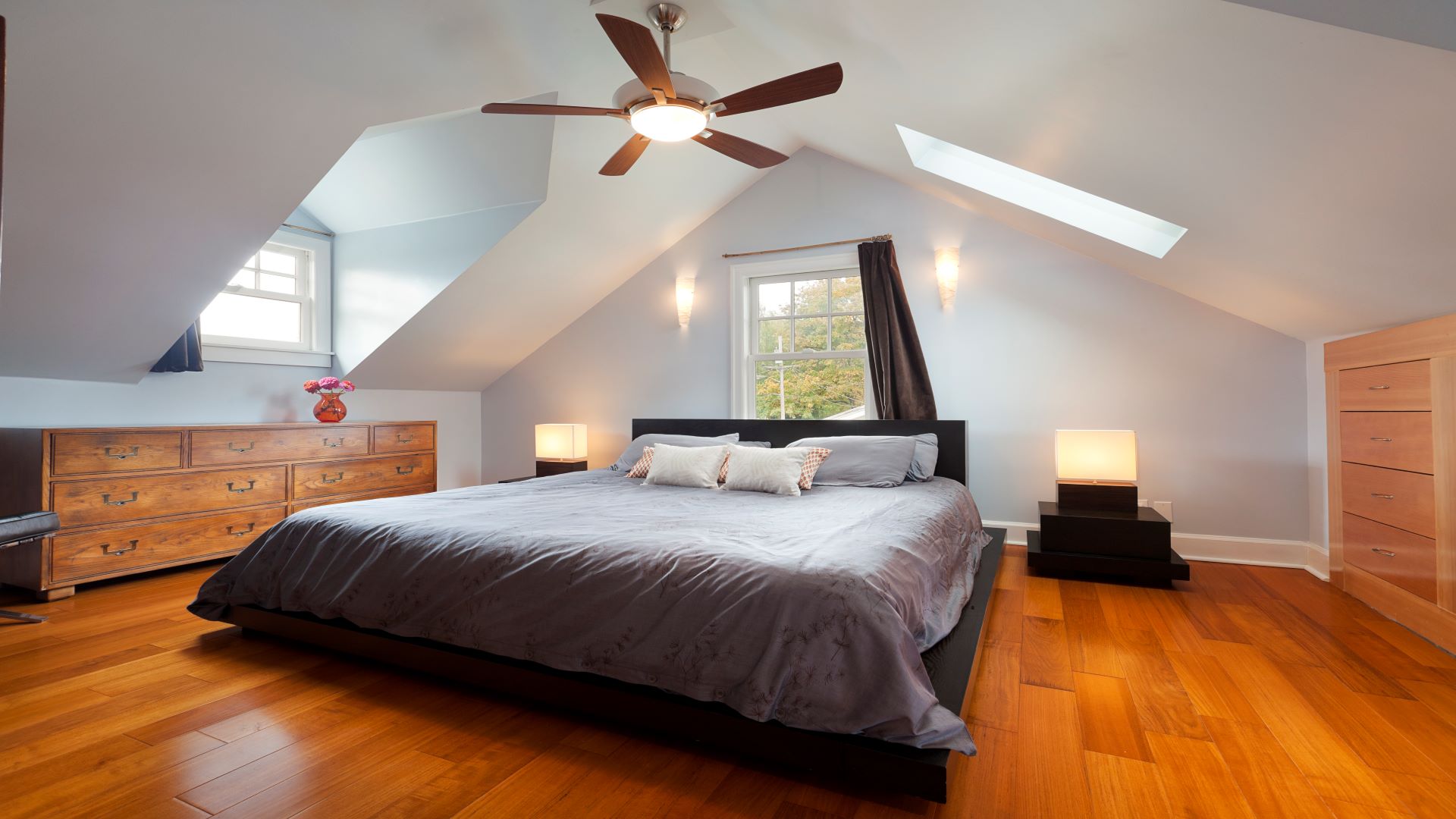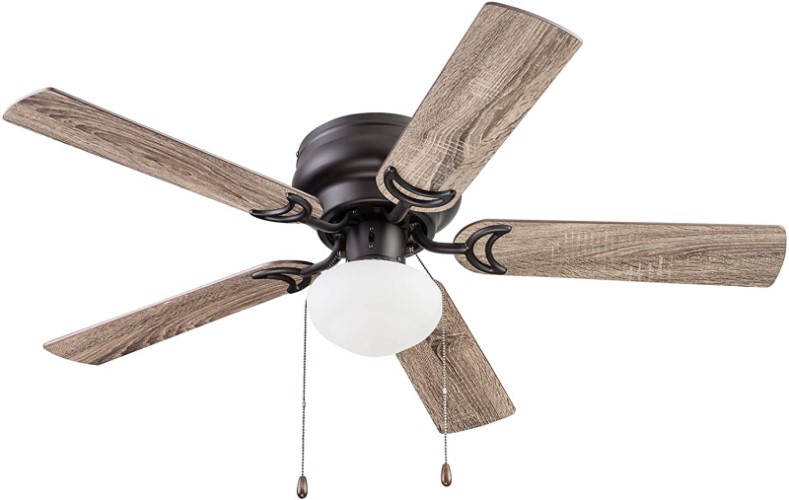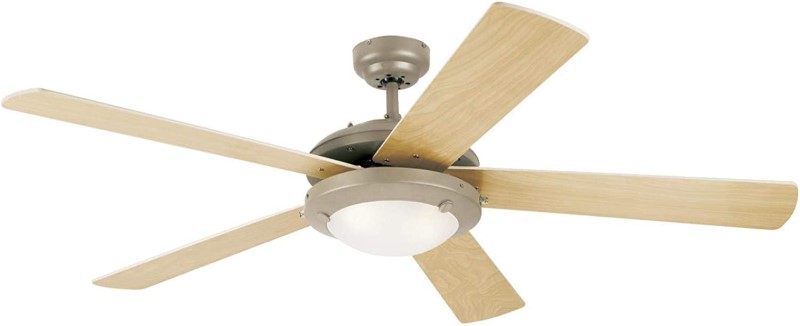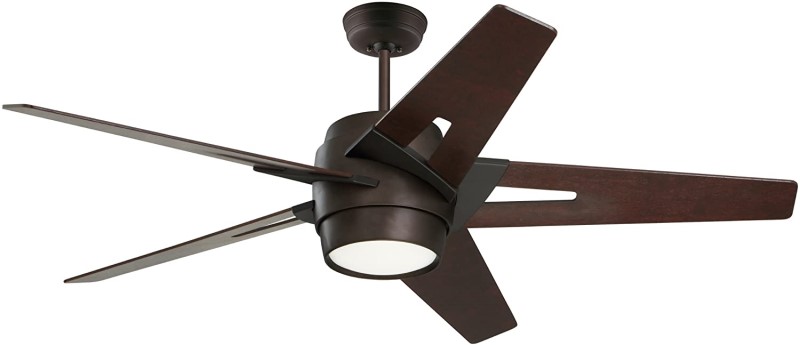Best Ceiling Fan
Choose the best ceiling fan for bedrooms and other areas of your home with our guide.

Need the best ceiling fan for your bedroom, living room, or other warm areas of your home? You’re in the right place as we’ve compared powerful ceiling fans from brands to discover the best of them. Modern ceiling fans will cool down a room, quietly operate, and some have ceiling fan lights too. A cheaper alternative to a central air conditioner, the best ceiling fans are an affordable way to keep you cool. These are our favorite ceiling fans.

Prominence Home Alvina Ceiling Fan
For indoor use
The Prominence Home Alvina ceiling fan features five, 44-inch revealable blades with different, traditional style finishes on each side. This makes it easy to update the look of your home without having to swap out the fan.
Pros:
- Quiet motor
- Reversable blades
Cons:
- Smaller blades
- Indoor use only
This fan includes a light kit with chain pulls to control both the light and the speed of the fan. The motor runs quietly and is reversible. This allows you to use the Alvina in both summer and winter. This ceiling fan is for indoor use only, but it is great for most living areas including bedrooms and home offices.

Hunter Builder Deluxe
Good choice for bedrooms
The Hunter Builder Deluxe ceiling fan is a good choice for bedrooms and other smaller rooms in your home. You can match this fan to most décors since it comes in three finishes: brushed nickel, new bronze, and white. Each style features reversible blades with different colors on each side.
Pros:
- Quiet motor
- Built to last
Cons:
- No remote control
The three-speed motor lets you reverse the direction for better performance in summer and winter. The Hunter Builder Deluxe fan comes with a balancing kit to reduce wobbles as its installed, which in turn makes the ceiling fan quieter at higher speeds. The fan doesn't include a remote control, so you should mount it low enough to reach the pull chain. However, it is compatible with a remote, so you can purchase on seperately if you need one.

Honeywell Carnegie Ceiling Fan
Features voice controls
This three-speed ceiling fan by Honeywell is easy to control. It comes with a remote control. It is also compatible with both the Amazon Echo and Google Home. You do need to purchase a Bond Home to connect the Carnegie ceiling fan with your smart home device.
Pros:
- Remote included
- Connects to smart home devices
- Reversable blades
Cons:
- Bond Home needed for smart features
The fan is made from both metal and wood laminate and features five reversible blades. One side is a warm, burnt oak color while the other has a mopane finish. The Honeywell Carnegie ceiling fan can be mounted in various ways, including from angled ceilings. It has three speeds and is compatible with dimmable light bulbs.

Westinghouse Lighting Comet
Good airflow rating
The 52-inch Westinghouse Lighting Comet mounts flush with the ceiling, but it is possible to mount it lower. The Comet's five blades create adequate air movement, and has an airflow rating of 3,589 CFM, which is enough for rooms up to 400 square feet. That is an area larger than a standard bedroom.
Pros:
- Can mount flush to the ceiling
- Suitable for room with low ceilings
Cons:
- Poor energy efficiency
This ceiling fan is designed to work outdoors, too, is adaptable to remote controls (a remote do not come with the fan), and has both an LED and non-LED lighting option. The glass covering the blubs is frosted to give a soft light and ambiance to your room. This fan has an average energy efficiency of 57 CFM per watt, which is lower than the minimum requirements to earn an Energy Star certification.

Emerson Luxe Eco
Energy Star certified
This fan has an airflow efficiency rating of 210 CFM per watt, making it one of the most efficient fans we looked at. The Emerson Luxe Eco has six speeds that are set using a wall control that is included.
Pros:
- Very energy efficient
- Unique contemporary design
- Removable light fixture
Cons:
- More expensive than other models
The five blades feature a unique, cutout design that complements contemporary styled decor. The motor housing has an oil-rubbed bronze finish while the blades are a dark mahogany color. The Luxe Eco has a light plate that can be removed if you decide to use just the fan. This ceiling fan is substantially more expensive than other models we looked at.
What to know before you buy
Why you can trust Top Ten Reviews
Before you pick a fan, here are a few things to consider.
The importance of airflow and blade span
Airflow is one of the biggest factors to consider when choosing a ceiling fan. The best fans have an airflow of 3,000 CFM or above. The CFM rating of the fan is the key consideration when choosing a fan, as it determines the area a fan will cool and circulate. The higher the CFM, the bigger area the fan will affect.
It's also important to consider the fan's blade span because that can affect the fan's airflow and efficiency as fans with longer blades circulate more air and are best in larger rooms.
What size ceiling fan should you get?
For rooms that are 144 Square Feet, a ceiling fan with a blade span under 42” and a CFM rating of 1,000 - 3,000. For a room between 144 - 225 square feet you should get a ceiling fan that has a 44” to 50” blade span and recommended CFM rating of 1,600 and 4,500.
If you have a room that is between 225 -400 square feet in area, fans with blade spans of over 50” is and a CFM rating of 2,300 and 6,500 is recommended. Anything over 400 square inches needs 62” blades with a CFM rating of 5,500 to 13,500.
How energy efficient are ceiling fans?
You can use your ceiling fan in conjunction with your air conditioning and heating to save money. Using the two devices increases the airflow of both hot and cold air and the area covered.
You can also choose an energy-efficient fan for increased savings. The most energy-efficient ceiling fans use less than 60 watts on average and have high airflow.
To qualify for Energy Star certification, a fan must produce at least 155 CFM, 100 CFM, and 75 CFM of airflow per watt on the high, medium, and low speeds respectively.
When planning your energy use, count built-in light fixtures separately, since manufacturers don't combine the fan and lighting wattage.
Ceiling fan mounting options and style
Different ceiling heights may require different fan mounts. If you have a low ceiling, choose a low-profile ceiling fan without a downrod so you don’t bump your head against the fan. Rooms with high or vaulted ceilings often require a downrod kit to lower the fan for better air circulation and access to the controls.
Whether it's modern, traditional, transitional, or mid-century, the fan should blend in with the style of your home. For example, polished metal fans with straight blades will likely fit in with modern décor, while traditional homes look best with elegant or rustic ceiling fans that have wood finishes and weathered bronze accents.
Lastly, the number of blades can imbue your space with a certain energy, relaxed or lively, even when the fan's not turning.
Ceiling fan convenience features
The cheapest ceiling fans often lack handheld remotes and dedicated wall controls, so it might be worth choosing a more expensive model for better control. A ceiling fan with a reversible motor lets you optimize the airflow direction for different seasons: counterclockwise during the summer to create a gentle breeze and clockwise during the winter to move heat near the ceiling throughout the room. Choosing a ceiling fan with at least three-speed settings allows you to fine-tune it to your comfort level.
How much do the best ceiling fans cost?
You can spend as little as $50 or well over $1,000 on a ceiling fan. However, you can expect to spend around $100 to $200 for the most popular models. As with most lighting or HVAC equipment, the cost of a fan generally goes up as its energy efficiency increases.
Premium blade materials, such as machined metal or natural wood, can also make a fan more expensive. There isn't a strong link between a fan's price and its blade size, blade shape, number of blades, airflow rating, or motor warranty, which means you can generally choose a design that fits your personal tastes and budget.
Best ceiling fans: Pros and cons
Advantages
Lower Ambient Temperature: Ceiling Fans can lower the temperature of a room by five degrees. This lower temperature is usually in addition to the other methods in the room, like an AC or open window.
Keep you Warm: During the summer, ceiling fans work by pushing the air downwards. This creates a disruption in the air, creating a breeze that helps cool down your skin. During the winter, most ceiling fans can be reversed to change the direction of airflow. Because warm air rises, the fan sucks up the cool air, forcing the warm air down.
Lowers the Bills: The fan both increases the heat and cooling effects in a room. This means you can set your thermostat so it cycles on and off less often, and work that your furnace and AC won’t have to work as hard.
Outdoor usage: Ceiling fans can cool outdoor areas, as well as, indoor areas. They are a great way to lower the temperature on the porch, patio, decking, in the sunroom, or outdoor kitchen.
Ambient Light Source: Most ceiling fans come with a built-in light, or a light kit to install lights. Some offer a decorative, moody style of lighting. Perfect for cozy nights in front of the television.
Disadvantages
Low Light Levels: While ceiling fans are great for providing low-level mood lighting, if you need a more powerful main light in the room, they are not the ideal ceiling fixtures to have.
Noisy: Many ceiling fans are designed to produce low levels of noise, and when they are newly installed they generally don’t produce much more than a whisper. But over time the bolts become looser, the blades can shift, and this can produce high levels of noise and squeaks. It takes a lot of maintenance to keep a ceiling fan quiet.
Pain to clean: The back of the blades tend to be dust magnets, and are hard to keep clean from floor height. This means they need to be cleaned with special poles or vacuum attachments. In some cases, you might even need a ladder.
Why trust us
At Top Ten Reviews we recommend the best products to enhance your life. As expert curators, we handpick products based on quality and usefulness to positively impact your day-to-day, from cart to doorstep. We take our responsibility seriously — testing products, reading reviews, and sourcing knowledgeable outlets to ensure our selections are worthy of your time and money. We deliver detailed product overviews, balancing objective information with subjective opinions, so making the best choice for your home and lifestyle is as easy as possible.
Sign up to receive the latest news, reviews, buying guides and deals direct to your inbox
John has been researching and reviewing home security and smart home products for Top Ten Reviews since 2013. As well as covering smart home and home security and safety, he also covers other home technology products such as HVAC, garage door openers and more. He enjoys DIY, writing and hiking in his spare time.

